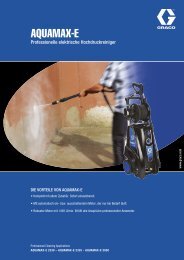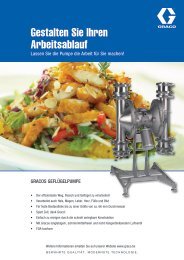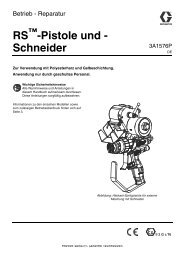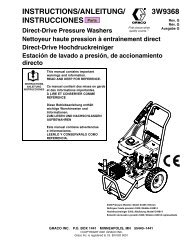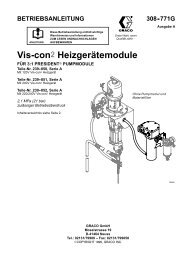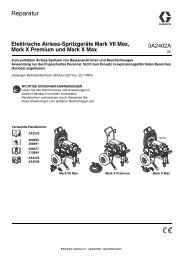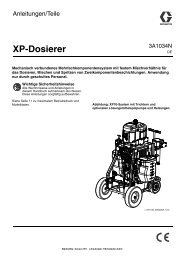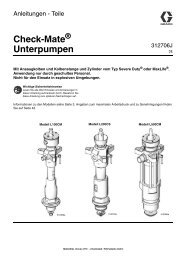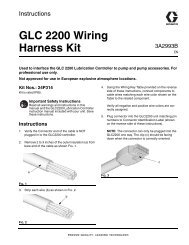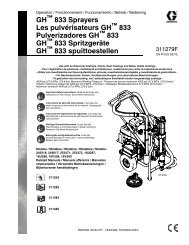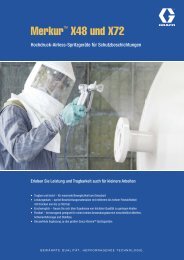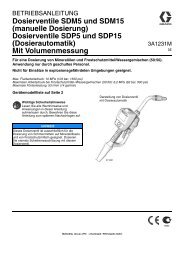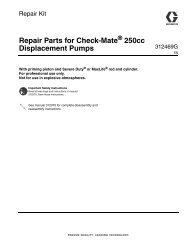ULTRA Plus+ 1500 Airless Paint Sprayer - Graco Inc.
ULTRA Plus+ 1500 Airless Paint Sprayer - Graco Inc.
ULTRA Plus+ 1500 Airless Paint Sprayer - Graco Inc.
Create successful ePaper yourself
Turn your PDF publications into a flip-book with our unique Google optimized e-Paper software.
-Motor Brush Replacement<br />
ELECTRIC SHOCK HAZARD<br />
To reduce the risk of Electric Shock: wait<br />
5 minutes after turning sprayer off before<br />
servicing to allow stored current to discharge.<br />
WARNING<br />
NOTE: Replace the brushes when they have worn to<br />
less than 0.4 in. See Fig. 10. Always replace both<br />
brushes at the same time. A Brush Repair Kit, p/n<br />
220–853, and spring clip, p/n 110–816, are available.<br />
NOTE: To maximize replacement brush life, break in new<br />
brushes by operating the sprayer with no load for at least<br />
one hour. To operate with no load, remove the pump<br />
connecting rod pin.<br />
WARNING<br />
INJECTION HAZARD<br />
To reduce the risk of serious injury,<br />
whenever you are instructed to relieve<br />
pressure, follow the Pressure Relief<br />
Procedure on page 7.<br />
Fig. 8<br />
A<br />
14<br />
1. Remove motor cover (14) and both inspection<br />
covers (A). See Fig. 8.<br />
<br />
2. Push in spring clip (D) to unhook, and then pull<br />
out. See Fig. 9.<br />
3. Loosen terminal screw (F). Pull brush lead (E)<br />
away, leaving motor lead (G) in place. Remove<br />
brush (C) and spring (B). See Fig. 10.<br />
4. Inspect commutator for excessive pitting, burning<br />
or gouging. A black color on commutator is normal.<br />
Have commutator resurfaced by qualified motor<br />
repair shop if brushes seem to wear too fast.<br />
5. Install new brush (C) so lead is in long slot (H) of<br />
holder. See Fig. 11. Slide the terminal (E) under<br />
the terminal screw washer. Make sure motor<br />
lead (G) is still connected the at screw. Tighten<br />
screw (F). See Fig. 10.<br />
6. Place spring (B) on brush as shown in Fig. 11.<br />
Spring must coil as shown.<br />
7. Push in and hook spring clip (D). See Fig. 11.<br />
8. Repeat for other side.<br />
9. Test brushes. Remove connecting rod pin (20).<br />
See Fig. 13, page 15. With sprayer off, turn pressure<br />
control knob fully counterclockwise to minimum<br />
pressure. Plug in sprayer. Turn sprayer on.<br />
Slowly increase pressure until motor is at full<br />
speed. Inspect brush and commutator contact<br />
area for excessive arcing. Arcs should not “trail” or<br />
circle around commutator surface.<br />
CAUTION<br />
Do not touch the brushes, leads, springs or brush<br />
holders while the sprayer is plugged in, to reduce the<br />
risk of electric shock and serious bodily injury.<br />
10. Install brush inspection plates, gaskets, and covers.<br />
11. Break in brushes. Operate sprayer for at least one<br />
hour with no load. Then reinstall connecting rod<br />
pin (20).



